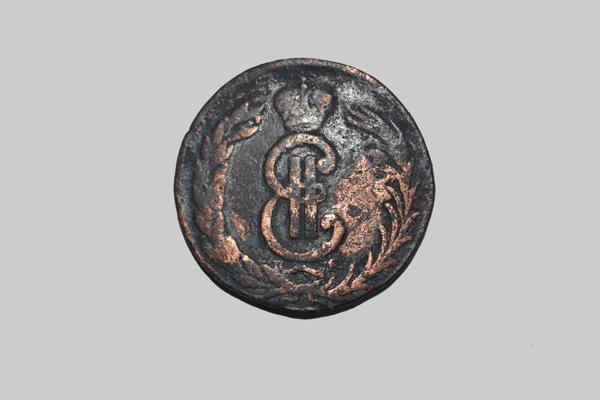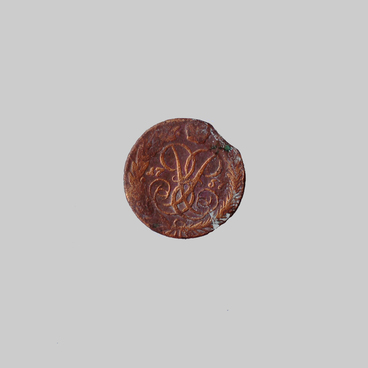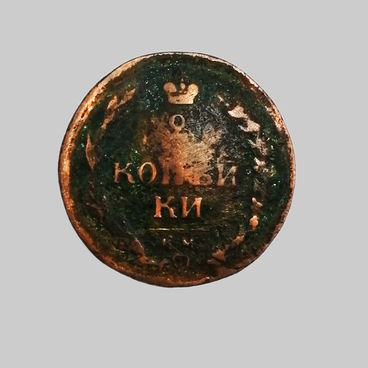The Karasuksky Regional Museum holds a solid copper two-kopek coin in its collection. The coin was minted by the Suzunsky Mint in Siberia.
Alongside the habitual Moscow coat of arms on the coin’s obverse, the main elements of the Siberian Kingdom’s coat of arms are also depicted: two Sables standing on their hind legs on a trapezium-shaped log platform. They are holding an oval cartouche decorated with plant-inspired decorations with their front paws. The coin’s value and year of issuance are printed on the cartouche: ‘TWO•KOPEKS• 1775’. A five-pronged crown is depicted above the cartouche, and ‘SIBERIAN • COIN’ is inscribed around the edge of the coin.
On the reverse, Catherine II’s cipher is positioned under the imperial crown. The cipher consists of the letter ‘E’ for ‘Catherine’ and the roman numeral ‘II’ for ‘the second’. The letters ‘K M’ are located beneath the cipher. These letters stand for ‘Kolyvan Copper’. This designation appears on two, five and ten-kopek coins from 1766 and parts of 1767. The coin’s edging has been preserved - it was often eroded through use. The coin’s edge or rim is cord-like - thin parallel cuts tilted to the right.
Siberian copper coins were minted between 1766 and 1781 at the Suzun mint. They were made during Catherine II’s reign following the suggestion of Ivan Schlatter. Schlatter was a member of the Collegium of Mining, which was an executive body for the Empire’s mining industry. 25 ruble runs were established - that is, 16.3 kilograms of copper would be turned into 25 rubles of one type of coin. The reduced mintage of Siberian coins, (usually 16 or 24 rubles were printed from the same amount of copper), was explained by the residues of silver and gold in the copper from which these coins were minted. At that time, there were no cost-effective methods for extracting silver and gold resides from Kolyvan copper. Siberian coins from 1763 and 1764 were minted at the Saint Petersburg mint as samples for the Suzun mint operators.
Originally, Siberian coins were issued with the intention that they would only be used in Siberia. Following a later decree, made on 30 July 1802, regarding ‘the free circulation of coins minted in Siberia throughout the nation’, the coins were accepted across the country. From 1824, they gradually came out of use, and from 1840, after the reforms lead by economist George Cancrin, the coins were no longer accepted.
Alongside the habitual Moscow coat of arms on the coin’s obverse, the main elements of the Siberian Kingdom’s coat of arms are also depicted: two Sables standing on their hind legs on a trapezium-shaped log platform. They are holding an oval cartouche decorated with plant-inspired decorations with their front paws. The coin’s value and year of issuance are printed on the cartouche: ‘TWO•KOPEKS• 1775’. A five-pronged crown is depicted above the cartouche, and ‘SIBERIAN • COIN’ is inscribed around the edge of the coin.
On the reverse, Catherine II’s cipher is positioned under the imperial crown. The cipher consists of the letter ‘E’ for ‘Catherine’ and the roman numeral ‘II’ for ‘the second’. The letters ‘K M’ are located beneath the cipher. These letters stand for ‘Kolyvan Copper’. This designation appears on two, five and ten-kopek coins from 1766 and parts of 1767. The coin’s edging has been preserved - it was often eroded through use. The coin’s edge or rim is cord-like - thin parallel cuts tilted to the right.
Siberian copper coins were minted between 1766 and 1781 at the Suzun mint. They were made during Catherine II’s reign following the suggestion of Ivan Schlatter. Schlatter was a member of the Collegium of Mining, which was an executive body for the Empire’s mining industry. 25 ruble runs were established - that is, 16.3 kilograms of copper would be turned into 25 rubles of one type of coin. The reduced mintage of Siberian coins, (usually 16 or 24 rubles were printed from the same amount of copper), was explained by the residues of silver and gold in the copper from which these coins were minted. At that time, there were no cost-effective methods for extracting silver and gold resides from Kolyvan copper. Siberian coins from 1763 and 1764 were minted at the Saint Petersburg mint as samples for the Suzun mint operators.
Originally, Siberian coins were issued with the intention that they would only be used in Siberia. Following a later decree, made on 30 July 1802, regarding ‘the free circulation of coins minted in Siberia throughout the nation’, the coins were accepted across the country. From 1824, they gradually came out of use, and from 1840, after the reforms lead by economist George Cancrin, the coins were no longer accepted.



